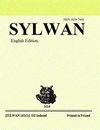RELATIONSHIP BETWEEN PHYSICOCHEMICAL PARAMETERS AND ANTIMICROBIAL ACTIVITY OF MOLDAVIAN HONEY
IF 0.6
4区 农林科学
Q4 FORESTRY
引用次数: 0
Abstract
Six samples of Moldavian honey from different regions were analyzed, physical and chemical parameters, the content of macro-, microelements, and aminoacids were determined, as well as antibacterial and antifungal activity. The antibacterial and antifungal properties were determined using the double serial dilution method. It was established that all of the samples of acacia, linden, and sunflower honey possess high antibacterial activity. The bioactivity of the samples of honey was proven to be dependent on the type and origin of honey. Sunflower honey has higher antibacterial potency than linden, but linden honey is more active than acacia. Both Gram-positive and Gram-negative bacterial species proved to be susceptible to Moldavian honey. Acacia, linden, and sunflower honey, possess high antibacterial potency against S. aureus and P. aeruginosa even at a dilution of 1:16 (2.5%). The studied samples showed weak antifungal activity against Candida albicans, with the MIC determined at 1:2 dilution (20%). For linden and sunflower honey, the antifungal activity was higher than for acacia honey. The samples with the best bioactivity (sunflower honey) contain a higher amount of free acids, had lower pH values of the honey solution, and these samples also have the highest content of OMF.摩尔达维亚蜂蜜理化参数与抗菌活性的关系
对6种不同产地的摩尔多瓦蜂蜜进行分析,测定其理化参数、宏量元素、微量元素和氨基酸含量,以及抗菌和抗真菌活性。采用双串联稀释法测定其抗菌和抗真菌性能。结果表明,金合欢蜜、椴树蜜和向日葵蜜均具有较高的抑菌活性。蜂蜜样品的生物活性被证明取决于蜂蜜的种类和产地。向日葵蜂蜜比菩提树蜂蜜具有更高的抗菌效力,但菩提树蜂蜜比金合欢更有活性。革兰氏阳性和革兰氏阴性细菌都对摩尔多瓦蜂蜜敏感。即使在1:16(2.5%)的稀释下,金合树、椴树和向日葵蜂蜜对金黄色葡萄球菌和铜绿假单胞菌也具有很高的抗菌效力。所研究的样品对白色念珠菌的抗真菌活性较弱,MIC在1:2稀释(20%)时测定。对椴树和向日葵蜂蜜的抑菌活性高于金合欢蜂蜜。生物活性最好的样品(向日葵蜂蜜)含有较多的游离酸,蜂蜜溶液的pH值较低,这些样品的OMF含量也最高。
本文章由计算机程序翻译,如有差异,请以英文原文为准。
求助全文
约1分钟内获得全文
求助全文
来源期刊

Sylwan
农林科学-林学
CiteScore
0.70
自引率
16.70%
发文量
0
审稿时长
1 months
期刊介绍:
SYLWAN jest najstarszym w Polsce leśnym czasopismem naukowym, jednym z pierwszych na świecie. Został założony w 1820 roku w Warszawie. Przyczynił się w znakomity sposób do rozwoju polskiego leśnictwa, służąc postępowi, upowszechnieniu wiedzy leśnej oraz rozwojowi nauki.
 求助内容:
求助内容: 应助结果提醒方式:
应助结果提醒方式:


